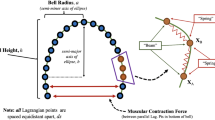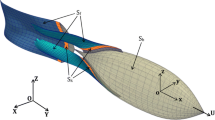Abstract
In nature, anguilliform fish swim fast and efficiently by undulating their elongate body in a specific way, which is generally described as a travelling wave. In present work, the undulatory motions of anguilliform fish are analyzed by the method of complex orthogonal decomposition (COD), and these particular motions are decomposed into two parts: the travelling component and standing component. The relative ratio between the travelling and standing components is defined as the travelling index, and the biological data show that anguilliform fish prefer to the undulatory motions with high travelling index (0.74–0.90). To study this phenomenon, a two-dimensional numerical model of anguilliform fish is developed by our proposed LS-IB numerical method, in which the shape of fish body is described by level-set (LS) function, and the interactive force is demonstrated by the immersed boundary (IB) method. The results show that the net force is decreased slightly with the travelling index, but the efficiency is increased with the travelling index until it reached to 0.8, which is consistent with the biological observations. Besides, the influences of the oscillating amplitude, tail-beat frequency and Strouhal number are also discussed. Overall, the results in present study can be used to explain why anguilliform fish would like to select the swimming gaits with high travelling index.
Similar content being viewed by others
Abbreviations
- A :
-
The maximum amplitude
- C f :
-
The net force coefficient
- C p :
-
The propulsive coefficient
- f i :
-
The interactive force at the forcing point
- f b :
-
The interactive force of solid body
- F :
-
The average net force (ANF)
- F 0 :
-
The ANF of tethered fish without any motions
- h (x, t):
-
The midline motions
- h i :
-
The lateral velocity
- H (x):
-
The amplitude envelope
- K a :
-
The amplitude coefficient
- k :
-
The wave number
- L :
-
The length of fish body
- \(\vec n\) :
-
The unit normal vector
- N :
-
The total number of forcing points.
- p :
-
The pressure
- P s :
-
The loss power acting on fish body
- Re:
-
Reynolds number
- St :
-
Strouhal number
- t n :
-
Time instants in one tail-beat period
- T :
-
The tail-beat period
- u i :
-
The velocity components
- U ∞ :
-
The velocity of incoming flow
- V :
-
The kinematic viscosity
- V :
-
The wave speed
- w :
-
The tail-beat frequency
- (w)(x):
-
The half width of fish body
- x i :
-
The Cartesian coordinates (x, y, z)
- x m :
-
Positions along the midline of fish body
- Δx :
-
Uniform grid size in x-direction
- Δy :
-
Uniform grid size in x-direction
- \(\phi \left( {\vec x,t} \right)\) :
-
The LS function
- α :
-
The amplitude growth rate
- λ :
-
The wave length
- γ :
-
The traveling index
- ρ :
-
The density
- τ ij :
-
Subgrid-scale (SGS) stress
- ϵ :
-
Three times of the minimal grid size
References
G. V. Lauder, Fish locomotion: recent advances and new directions, Annual Review of Marine Science, 7 (2015) 521–545.
J. Yu et al., Motion control and motion coordination of bionic robotic fish: a review, Journal of Bionic Engineering, 15(4) (2018) 579–598.
J. E. Colgate and K. M. Lynch, Mechanics and control of swimming: a review, IEEE Journal of Oceanic Engineering, 29 (2004) 660–673.
J. J. Videler, Fish Swimming, Springer Science and Business Media, Dordrecht (1993).
G. V. Lauder and E. D. Tytell, Hydrodynamics of undulatory propulsion, Fish Physiology, 23 (2005) 425–468.
Z. Cui and H. Jiang, Complex modal decomposition and characteristics analysis of the midline motions of swimming fish propelled by undulating body and caudal fin, Journal of Unmanned Undersea Systems, 28(2) (2020) 119–125.
I. Borazjani and F. Sotiropoulos, On the role of form and kinematics on the hydrodynamics of self-propelled body/caudal fin swimming, Journal of Experimental Biology, 213 (2010) 89–107.
E. D. Tytell et al., Body stiffness and damping depend sensitively on the timing of muscle activation in lampreys, Integrative and Comparative Biology, 58(5) (2018) 860–873.
Z. Cui et al., Complex modal analysis of the movements of swimming fish propelled by body and/or caudal fin, Wave Motion, 78 (2018) 83–97.
B. F. Feeny, A complex orthogonal decomposition for wave motion analysis, Journal of Sound and Vibration, 310 (2008) 77–90.
B. F. Feeny and A. K. Feeny, Complex modal analysis of the swimming motion of a whiting, Journal of Vibration and Acoustics, 135 (2013) 021004.
J. L. Lim and G. V. Lauder, Mechanisms of anguilliform locomotion in fishes studied using simple three-dimensional physical models, Bioinspiration and Biomimetics, 11 (2016) 046006.
Z. Cui and H. Jiang, Design and implementation of thunniform robotic fish with variable body stiffness, International Journal of Robotics and Automation, 32 (2017) 109–116.
S. Kern and P. Koumoutsakos, Simulations of optimized anguilliform swimming, Journal of Experimental Biology, 209 (2006) 4841–4857.
Z. Cui, Z. Yang and H. Jiang, Sharp interface immersed boundary method for simulating three-dimensional swimming fish, Engineering Applications of Computational Fluid Mechanics, 14(1) (2020) 534–544.
M. S. Triantafyllou, G. S. Triantafyllou and D. K. P. Yue, Hydrodynamics of fishlike swimming, Annual Review of Fluid Mechanics, 32 (2000) 33–53.
M. Gazzola, W. M. Van Rees and P. Koumoutsakos, C-start: optimal start of larval fish, Journal of Fluid Mechanics, 698 (2012) 5–18.
Z. Cui, Z. Yang, H. Jiang, L. Shen and W.-X. Huang, A sharpinterface immersed boundary method for simulating incompressible flows with arbitrarily deforming smooth boundaries, International Journal of Computational Methods, 14 (2017) 1750080.
M. Sussman, P. Smereka and S. Osher, A level set approach for computing solutions to incompressible two-phase flow, Journal of Computational Physics, 114 (1994) 146–159.
G. Russo and P. Smereka, A remark on computing distance functions, Journal of Computational Physics, 163 (2000) 51–67.
M. Germano, U. Piomelli, P. Moin and W. H. Cabot, A dynamic subgrid-scale eddy viscosity model, Physics of Fluids, 3 (1991) 1760–1765.
D. K. Lilly, A proposed modification of the Germano subgrid-scale closure method, Physics of Fluids, 4 (1992) 633–635.
I. Borazjani and F. Sotiropoulos, Numerical investigation of the hydrodynamics of anguilliform swimming in the transitional and inertial flow regimes, Journal of Experimental Biology, 212 (2009) 576–592.
U. K. Muller, J. Smit, E. J. Stamhuis and J. J. Videler, How the body contributes to the wake in undulatory fish swimming: flow fields of a swimming eel (Anguilla anguilla), Journal of Experimental Biology, 204 (2001) 2751–2762.
R. Bainbridge, The speed of swimming of fish as related to size and to the frequency and amplitude of the tail beat, Journal of Experimental Biology, 35 (1958) 109–133.
J. M. Donley and K. A. Dickson, Swimming kinematics of juvenile kawakawa tuna (Euthynnus affinis) and chub mackerel (Scomber japonicus), Journal of Experimental Biology, 203 (2000) 3103–3116.
E. D. Tytell and G. V. Lauder, The hydrodynamics of eel swimming, Journal of Experimental Biology, 207 (2004) 1825–1841.
L. Shen, X. Zhang, M. S. Triantafyllou and D. K. P. Yue, Turbulent flow over a flexible wall undergoing a streamwise traveling wave motion, Journal of Fluid Mechanics, 484 (2003) 197–221.
D. S. Barrett, M. S. Triantafyllou and D. K. P. Yue, Drag reduction in fishlike locomotion, Journal of Fluid Mechanics, 392 (1999) 183–212.
C. Eloy, Optimal Strouhal number for swimming animals, Journal of Fluids and Structures, 30 (2012) 205–218.
J. Gray, Animal locomotion, Sciences, 162(3850) (1968) 249.
D. J. Ellerby and J. D. Altringham, Spatial variation in fast muscle function of the rainbow trout Oncorhynchus mykiss during fast-starts and sprinting, Journal of Experimental Biology, 204 (2001) 2239–2250.
Acknowledgments
This work is supported by the National Natural Science Foundation of China (No. 12002097), the Natural Science Foundation of Guizhou Provice (No. ZK[2021]-266, No. [2017]5789-20), and the Scientific Start-up Project of GuiZhou Institute of Technology (XJGC20190956).
Author information
Authors and Affiliations
Corresponding author
Additional information
Zuo Cui received his Ph.D. degree in Mechanical Engineering from Harbin Institute of Technology, in 2017. Currently, he is an Associate Professor in the School of Aerospace Engineering, Guizhou Institute of Technology, China. His research interest covers biofluid mechanics, bionic robotics, computational fluid dynamics.
Hongzhou Jiang received his Ph.D. degree in Mechanical Engineering from Harbin Institute of Technology, in 2001. Currently, he is a Professor in the Department of Mechanical Engineering at Harbin Institute of Technology, China, and a member of Chinese Society of Astronautics. He has published about 70 refereed journal and conference papers. His research interest covers parallel robotics, control systems, and hydrodynamic control system.
Rights and permissions
About this article
Cite this article
Cui, Z., Jiang, H. Numerical study of complex modal characteristics in anguilliform mode of fish swimming. J Mech Sci Technol 35, 4511–4521 (2021). https://doi.org/10.1007/s12206-021-0921-5
Received:
Revised:
Accepted:
Published:
Issue Date:
DOI: https://doi.org/10.1007/s12206-021-0921-5




